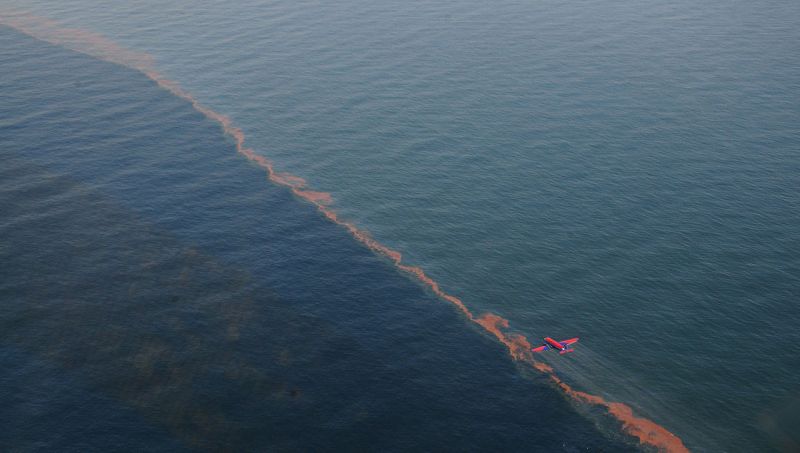Sunlight Reduces Effectiveness of Dispersants Used in Oil Spills
Published on by Water Network Research, Official research team of The Water Network in Academic
Two new studies have shown that sunlight transforms oil on the ocean surface more significantly and quickly than previously thought. The phenomenon considerably limits the effectiveness of chemical dispersants, which are during oil spills to break up floating oil and reduce the amount of oil that reaches coastlines.
A research team led by Woods Hole Oceanographic Institution (WHOI) found that sunlight chemically alters crude oil floating on the sea surface within hours or days. In a follow-up study the team reported that sunlight changes oil into different compounds that dispersants cannot easily break up. The results of these two studies could affect how responders decide when, where, and how to use dispersants.

An airplane sprays chemical dispersants on an oil slick in the Gulf of Mexico during the 2010 Deepwater Horizon oil spill. Two new studies have shown that sunlight transforms oil on the ocean surface more significantly and quickly than previously thought. The phenomenon considerably limits the effectiveness of chemical dispersants, which are designed to break up floating oil and reduce the amount of oil that reaches coastlines. (Stephen Lehmann, U.S. Coast Guard), Via: WHOI
The related studies were published on February 20, 2018, in the Journal Environmental Science & Technology and April 25, 2018 in the journal Environmental Science & Technology Letters.
“It has been thought that sunlight has a negligible impact on the effectiveness of dispersants,” said Collin Ward, a scientist at WHOI and lead author of both studies. “Our findings show that sunlight is a primary factor controlling how well dispersants perform. And because photochemical changes happen fast, they limit the window of opportunity to apply dispersants effectively.”
Dispersants contain detergents, not unlike those people use to wash dishes, which help break oil into small droplets that can become diluted in the ocean, and/or are eaten by microbes before the oil can be swept to sensitive coastlines. But to do their work, the detergents (also known as surfactants) first need to mix with both the oil and water—and oil and water, famously, don’t mix.
To overcome this barrier, dispersants contain an organic solvent that helps the oil, detergents, and water to mix. Only once this key step occurs can the surfactants do their work to break oil into droplets. But sunlight hinders this key step, the new studies show.
Before dispersants can even be applied, light energy from the sun is already breaking chemical bonds in oil compounds—splitting off atoms or chemical chains and creating openings for oxygen to attach. This photo-oxidation process (also known as photochemical “weathering”) is similar to the process that causes paint on your car or colors on your clothes to fade if they are left out in the sun for too long.
To date, tests to determine dispersants’ effectiveness used only “fresh” oil that hadn’t been altered by sunlight. In the new studies, the researchers conducted extensive lab tests exposing oil to sunlight. They showed that sunlight rapidly transforms oil into residues that are only partially soluble in a dispersant’s solvent. That limits the ability of detergents to mix with the photo-oxidized oil and break the oil into droplets.
The finding suggests that responders should factor in sunlight when determining the “window of opportunity” to use dispersants effectively. That window will be far shorter than previously thought on sunny days than it would on cloudy days.
Read full article: WHOI
Media
Taxonomy
- Oil & Gas
- Decontamination
- Oil Water Separation
- Pollution
- Marine
- Contaminant Movement Mapping
- Oceanographic Survey
- Oil Spill Treatments
- Pollution